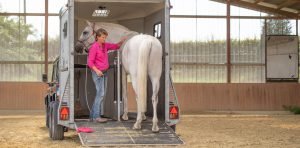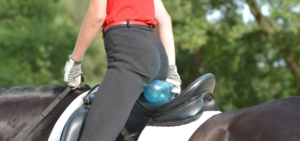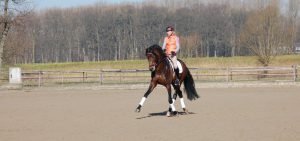Working on long reins is a fascinating and supreme discipline of classical horse training. This requires a lot of trust between horses and humans because only a few aids are available to the trainer to communicate with his horse in all gaits and lessons.
Table of Contents:
- The first time on long reins
- Straight ahead is underrated
- Saskia Gunzer’s training principles when working on long reins
- Your task on the long rein
- The most common problems when getting started with long reins
- 5 misunderstandings when working on long reins
- Courses for preparatory work on long reins
The first time working your horse on long reins: Every beginning is difficult
Before working on the long reins, you need to learn to work in hand. Your horse will benefit enormously from this – under the saddle and later on the long reins. We have listed the most common mistakes and most important steps at the beginning of the training so that you are well prepared! Long reins expert Saskia Gunzer explains in a very practical way how you can get started.
At first, it’s only straight ahead. And that applies to work-in-hand as well as with long reins. In order to be effective on the long reins, a lot of basics have to be in place. It is important to be careful in the beginning. It will feel unspectacular, but it will teach you so much! Saskia Gunzer puts it this way: “Many horse people proudly say: My horse can do half passes, croup in, wonderful! But just letting the horses go straight, with two hoofprints in the sand, that’s so important.”

Straight ahead is underrated
If the transitions between stop, walk, and trot are already successful and finely tuned in the preparatory work in hand, you can think about starting work on the long rein. Of course, it doesn’t do any harm if you’ve already practiced even more in-hand work.
Two things can cause initial hurdles in long reining: First, the horse must understand “Go ahead of me.” Second, the horse’s shoulder control must be trained. In order to control the shoulder, it is initially important to have the horse hollow inside: the croup has to be pushed in a little so that the horse’s shoulder can come out again and the horse does not unintentionally leave the hoof slack. Don’t help with the whip and drift sideways – “we only use the whip for energy.”
Saskia Gunzer’s training principles when working your horse on long reins
- “Work in such a way that I can give in as quickly as possible.”
- “The whip is used delicately, like a fly.”
- During work: “Keep your distance! There should be a distinct human part and horse part.”
- “Don’t put aggression into what you’re doing. Being assertive and consistent is good, but not aggressive.”
The trot is added quite quickly
Put into practice, it looks like this: stop-step-stop is the first task. “It’s very important to quickly take control as a human when doing long rein work,” says Saskia Gunzer. “If you get the impression in the first long rein session that your horse isn’t listening, it’s important to focus on training the stop. Once that’s trained safely, the trainer quickly adds stop-trot-stop, because it shouldn’t be boring! Saskia Gunzer usually quickly adds the trot, because otherwise, horses would quickly lose their attention. When she says many transitions, she means distances like “trot at K, stop at B.” Sounds easy? Well, problems can arise even with these simple things. More on that in a moment.
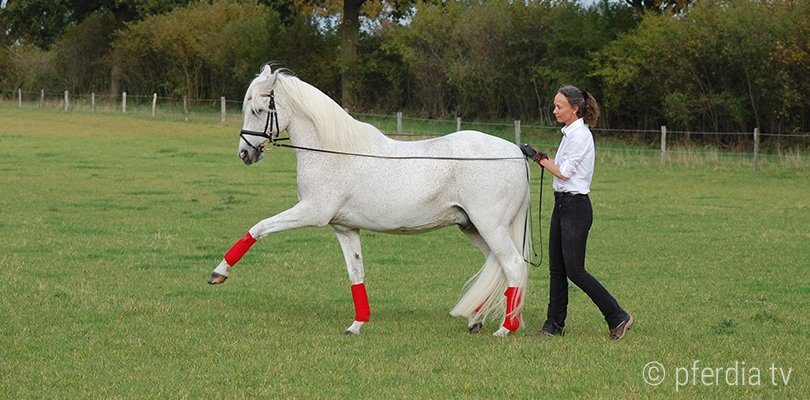
Your task on the long rein
You don’t “just” follow your horse on the long reins. Your posture and the correct use of the reins are particularly important so that communication between you and your horse works properly.
Working position in-hand
- Pass the reins over your horse’s neck. One hand is at your horse’s shoulder level, and the other one grips the reins close to the bit ring
- A whip is used as an extension of the index finger pointing backward. Stay in control of the outside rein.
Human posture when using long reins
- Put your hands next to the root of the tail. “And not on top, as if the croup were a tray.”
- Let the upper arms hang down loosely, and don’t spread your hands too widely, “Otherwise there will be tension in the shoulder region,” explains the trainer.
- Engage through your own body! Tightening the lower back also applies to people who work on long reins. Don’t fall backward with a round back.
The most common problems when getting started with long reins
As easy as the step-hold-step on the long rein sounds, beginners quickly realize that even walking straight can be quite challenging. The most common problems when getting started are:
Problem 1: The horse is impulsive
Then you should pay particular attention to principle number 1: “Work in such a way that you can give in as soon as possible.” You have to gain access to the motor and train half halts to be able to use these aids to help your horse balance. If a short distance has been walked forward with diligence, then say “fine, because he was listening.” You want to work to the point, not get pulled around. A forward step is always good, but don’t misunderstand it with letting yourself be pulled around the arena. That’s why transitions are so important.
Problem 2: The croup comes in
Important: Do not try to solve the problem with your inner hand. “The inner hand is just there, it doesn’t pull.” The shoulder is brought in with the outside rein and with the posture of the human – you have to clear the way optically. So you give increased contact on the outside rein and rotate your shoulder in the direction you would like to position the horse’s shoulders. “Most of the time, the horses follow the changed posture of the human being,” says Saskia Gunzer. Incidentally, this works very similarly when working in hand and long reins. Remember to step back to give yourself enough space when working by hand – this is often necessary for a situation like this.
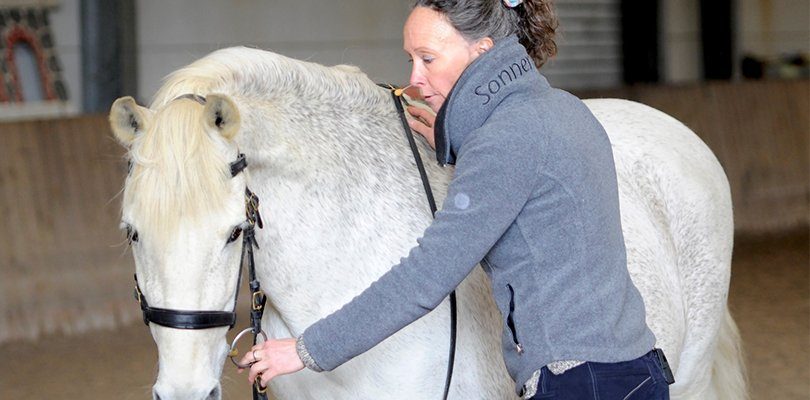
Problem 3: The horse closes in to stop when moving
This can happen with horses that initially move rather jaggedly when the aids are not yet flowing smoothly through the horse. It is important to help the horse find its way down. Chewing exercises while standing can help. The reins lie on the neck, the buckle in the middle. The human takes the inner teeth ring and works gently downwards. “It’s important to give in immediately when the horse gives in.” says Saskia Gunzer. It is essential to ensure that the horse’s head remains straight during the exercise. Also, make sure that the horse lets go at the base of the neck when lowering, the horse must let go from the withers so that the back can come up later. When standing, the horse may lead its nose up to 20 cm above the ground for correction. “This standing still, breathing, and coming to rest is very important,” explains Saskia Gunzer. “The horses get into a listening mode, and we need that for the training.”

5 misunderstandings when working on long reins with your horse
Andreas Hausberger works as a senior rider at the Spanish Riding School in Vienna. Two of his specialties are long-rein and in-hand work. Clients, often international sport riders, come to him for advice on how to improve piaffe and passage work from the ground. We wanted to hear from him about which misunderstandings are the most common in this work.
1. Underestimating the work
“Working on long reins looks so easy for me or at the Riding School. Then a lot of people think: I can do that too, and just give it a try,” says Andreas Hausberger. This method is often underestimated – and then things go wrong. “Especially the in-hand work or the work on the long reins requires so much self-control, empathy, and an incredibly finely-ridden horse.”
2. Working a young horse on long reins
Did you read the last quote from Andreas Hausberger carefully? He explains the sequence of training here: before working on the long rein, the horse must already have been ridden gently. Young horses are trained in-hand at the same time as they are trained in the saddle, but not on long reins.
3. Training in an unfavorable position
The distance between man and horse is crucial. “Many people think: if they have a half-distance to the horse, that is just right for working on the long reins. But that’s wrong!” says Andreas. “Either the trainer walks very close behind the horse, with fists touching the croup. Or he goes so far away from the horse that if the horse kicks, it cannot touch the human. Only these two distances are helpful.”
4. Not controlling your own body
It is essential to observe yourself closely in order to correctly give the aids on the long rein and to accompany the horse correctly from the ground. From the ground, the same applies as in the saddle: people must have their own body language under control.
5. Not being able to read the horse’s body language
“If I can’t read the horse’s body language, I’ll never be successful in long-rein work, ever,” says Andreas Hausberger. That’s because the trainer has to recognize whether the horse is working correctly through and with its body and what condition it is in. “Dressage is there for the horse, not the other way around.”
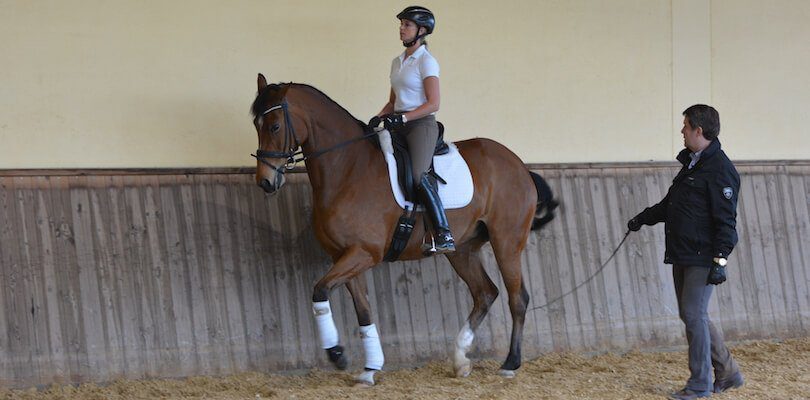
Do you want to learn more about groundwork and long reining? Then visit our website.




